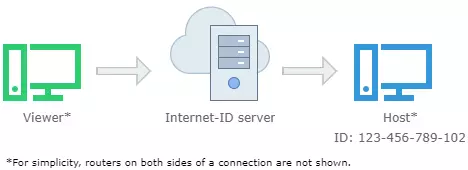What is an Internet-ID connection?
How it works
An Internet-ID connection uses an intermediate server on the Web ("Internet-ID server") to facilitate connection between Viewer and Host. This connection type can be used where a direct connection is not possible.

The Internet-ID connection does not require router or firewall configuration. To establish an Internet-ID connection please follow this guide.
Internet-ID code
An Internet-ID code is a unique 12-digit number assigned to a remote Host or Agent. When the Internet-ID connection is established, the code is used as the address of the remote Host or Agent.

Internet-ID server
When setting up the Internet-ID connection you can choose which intermediate server to use. There are two options:
- Public Internet-ID servers that use our company infrastructure. This is the default and simplest option.
- RU Server. This is a self-hosted module that you can deploy on your premises and set up remote connection routing.
Troubleshooting Internet-ID connections
To troubleshoot issues with Internet-ID connectivity please refer to this guide.